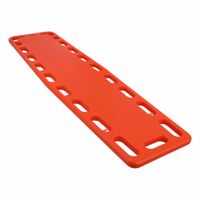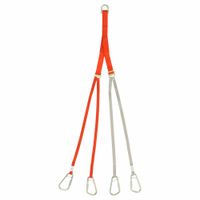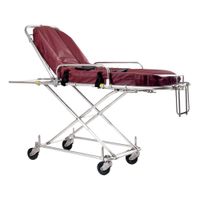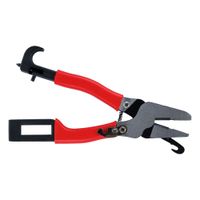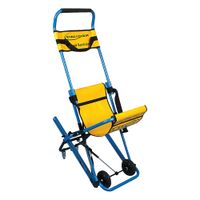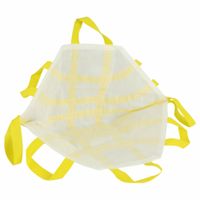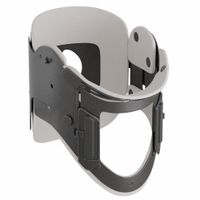Call +(254) 703 030 000 / 751 483 999 / 721 704 777
- Home
- Safety
- Medical Supplies Equipment
- Ems Rescue Tools
.....Read More
Frequently Asked Questions
What are the essential EMS and rescue tools for first responders?
Essential EMS and rescue tools for first responders include:
1. **Personal Protective Equipment (PPE):** Gloves, masks, eye protection, and gowns to ensure safety from infections and hazardous materials.
2. **Basic Life Support (BLS) Equipment:**
- **Automated External Defibrillator (AED):** For cardiac arrest situations.
- **Bag-Valve-Mask (BVM):** For manual ventilation.
- **Oxygen Supply:** Portable tanks and masks for oxygen administration.
3. **Airway Management Tools:**
- **Oropharyngeal and Nasopharyngeal Airways:** To maintain open airways.
- **Suction Devices:** For clearing obstructions.
4. **Trauma Care Supplies:**
- **Tourniquets and Hemostatic Dressings:** For bleeding control.
- **Splints and Immobilization Devices:** For fractures and spinal injuries.
- **Bandages and Dressings:** For wound care.
5. **Monitoring Devices:**
- **Pulse Oximeter:** To measure oxygen saturation.
- **Blood Pressure Cuff and Stethoscope:** For vital signs assessment.
6. **Communication Equipment:**
- **Radios and Mobile Devices:** For coordination and information relay.
7. **Rescue Tools:**
- **Extrication Devices:** Such as hydraulic spreaders and cutters for vehicle rescues.
- **Ropes and Harnesses:** For high-angle or confined space rescues.
8. **Lighting and Visibility Gear:**
- **Flashlights and Headlamps:** For low-light conditions.
- **Reflective Vests:** For visibility in traffic or crowded scenes.
9. **Documentation Tools:**
- **Notebooks and Pens:** For recording patient information and incident details.
10. **Miscellaneous:**
- **Multi-tools and Knives:** For various tasks.
- **Blankets and Tarps:** For patient warmth and privacy.
These tools are crucial for effective response and patient care in emergencies.
How do evacuation chairs assist in emergency situations?
Evacuation chairs are specialized devices designed to assist in the safe and efficient evacuation of individuals with mobility impairments during emergency situations, such as fires, earthquakes, or other emergencies requiring rapid building evacuation. These chairs are particularly useful in multi-story buildings where elevators cannot be used during emergencies.
The primary function of evacuation chairs is to enable a single operator to transport a person down stairs with minimal physical effort. They are equipped with features such as tracks or treads that allow the chair to glide smoothly down staircases, reducing the need for lifting and minimizing the risk of injury to both the operator and the evacuee. The design often includes safety belts, headrests, and footrests to secure the individual during transit.
Evacuation chairs are lightweight and compact, making them easy to store and quickly deploy in an emergency. They are typically located in strategic areas within a building, such as near stairwells, to ensure quick access. Training is often provided to staff to ensure they can operate the chairs effectively and safely.
In addition to stair descent, some evacuation chairs are designed for horizontal movement, allowing for the transport of individuals across flat surfaces to a safe location. This versatility is crucial in ensuring that all individuals, regardless of mobility challenges, can be evacuated efficiently.
Overall, evacuation chairs play a critical role in emergency preparedness plans, ensuring compliance with accessibility regulations and enhancing the safety of all building occupants by providing a reliable means of evacuation for those who cannot use stairs independently.
What is the purpose of EMS stretchers in patient transport?
The purpose of EMS stretchers in patient transport is to ensure the safe, efficient, and comfortable movement of patients from the scene of an incident to a healthcare facility. EMS stretchers are designed to provide stability and support to patients, minimizing the risk of further injury during transport. They are equipped with features such as adjustable height, wheels for mobility, and secure straps to keep the patient in place, which are crucial for navigating various terrains and environments.
These stretchers are essential for emergency medical services as they allow for the rapid and effective transport of patients, which is critical in time-sensitive situations. They help in reducing the physical strain on EMS personnel by allowing them to move patients with minimal lifting, thus preventing injuries to both the patient and the responders.
Additionally, EMS stretchers are often designed to accommodate various medical equipment, such as IV poles and oxygen tanks, ensuring that necessary medical interventions can continue during transport. This capability is vital for maintaining patient stability and providing continuous care en route to the hospital.
In summary, EMS stretchers play a crucial role in patient transport by ensuring safety, enhancing mobility, and facilitating ongoing medical care, thereby improving overall patient outcomes in emergency situations.
How do EMS backboards help in spinal injury cases?
EMS backboards are crucial in managing spinal injury cases as they provide immobilization and support to prevent further injury. When a spinal injury is suspected, any movement can exacerbate the damage, potentially leading to paralysis or other severe complications. The backboard helps maintain the spine in a neutral position, minimizing movement during transport.
The process begins with careful log-rolling of the patient onto the backboard, ensuring the spine remains aligned. Straps and head immobilizers are then used to secure the patient, preventing any shifts during movement. This immobilization is vital during transport to medical facilities, where further assessment and treatment can occur.
Backboards are also beneficial in extrication scenarios, where patients need to be moved from confined spaces or awkward positions. They provide a stable platform, allowing rescuers to lift and carry the patient safely.
While backboards are essential in pre-hospital care, their use is often limited to transport due to potential complications from prolonged use, such as pressure sores or respiratory issues. Therefore, they are typically used in conjunction with other spinal precautions and are removed once the patient is in a controlled environment where further spinal assessment can be conducted.
In summary, EMS backboards are a vital tool in the initial management of spinal injuries, providing necessary immobilization to prevent further harm during transport and extrication.
When should trauma cervical collars be used?
Trauma cervical collars should be used in the following situations:
1. **Suspected Cervical Spine Injury**: When there is a suspicion of cervical spine injury due to trauma, such as in motor vehicle accidents, falls from significant heights, or sports injuries, a cervical collar is applied to immobilize the neck and prevent further injury.
2. **Blunt Force Trauma**: In cases of blunt force trauma to the head or neck, a cervical collar is used to stabilize the cervical spine until a thorough assessment can be conducted.
3. **Neurological Symptoms**: If a patient exhibits neurological symptoms such as numbness, tingling, or weakness in the limbs following trauma, a cervical collar is applied to prevent potential spinal cord damage.
4. **Altered Mental Status**: Patients with altered mental status, such as those who are unconscious or have a decreased level of consciousness after trauma, should have a cervical collar applied as a precautionary measure.
5. **Intoxication**: In cases where the patient is under the influence of alcohol or drugs, and a reliable assessment of cervical spine injury cannot be made, a cervical collar is used until further evaluation is possible.
6. **Penetrating Neck Injuries**: Although controversial, some protocols suggest using cervical collars in penetrating neck injuries if there is a risk of spinal injury, but this should be done with caution to avoid exacerbating the injury.
7. **Pre-Hospital Care**: Emergency medical services often apply cervical collars as part of their standard protocol for trauma patients during transport to a medical facility.
8. **Transport and Transfer**: During the transport and transfer of patients with potential cervical spine injuries, cervical collars are used to maintain spinal alignment and prevent movement.
Cervical collars are a temporary measure and should be used in conjunction with other immobilization techniques and diagnostic imaging to confirm or rule out cervical spine injuries.
What are the benefits of using EMS gurneys and pads?
EMS gurneys and pads offer several benefits that enhance patient care and improve operational efficiency for emergency medical services.
1. **Patient Safety and Comfort**: EMS gurneys are designed to safely transport patients, minimizing the risk of injury during movement. They often come with adjustable features to accommodate various patient sizes and conditions, ensuring comfort. Pads provide additional cushioning, reducing pressure points and enhancing comfort during transport.
2. **Ease of Use**: Modern gurneys are equipped with hydraulic or electric systems that allow for easy height adjustment, making it simpler for EMS personnel to lift and lower patients, reducing the risk of back injuries. The maneuverability of gurneys, with features like swivel wheels, allows for smooth navigation through tight spaces.
3. **Quick and Efficient Transport**: Gurneys facilitate rapid patient transport from the scene to the ambulance and then to the hospital, which is crucial in emergency situations. The design allows for quick loading and unloading, saving valuable time.
4. **Versatility**: Many EMS gurneys are equipped with features like IV poles, oxygen tank holders, and storage compartments, allowing for comprehensive patient care during transport. They can be adapted for various medical situations, from trauma to cardiac emergencies.
5. **Infection Control**: Gurneys and pads are made from materials that are easy to clean and disinfect, helping to maintain hygiene and prevent the spread of infections.
6. **Durability and Reliability**: Built to withstand rigorous use, EMS gurneys are durable and reliable, ensuring they perform well under the demanding conditions of emergency medical services.
7. **Improved Patient Outcomes**: By ensuring safe, comfortable, and efficient transport, EMS gurneys and pads contribute to better patient outcomes, as timely and effective care can be administered en route to medical facilities.
How do patient transfer sheets and straps aid in moving patients?
Patient transfer sheets and straps are essential tools in healthcare settings for safely and efficiently moving patients. These devices aid in minimizing the risk of injury to both patients and healthcare providers during transfers.
Transfer sheets, often made of low-friction materials, allow caregivers to slide patients from one surface to another, such as from a bed to a stretcher. The slick surface reduces the effort required to move a patient, thereby decreasing the physical strain on healthcare workers and reducing the risk of musculoskeletal injuries. Additionally, transfer sheets help maintain patient dignity and comfort by providing a smooth and controlled movement.
Straps, on the other hand, provide secure handling and stabilization during transfers. They are typically used in conjunction with transfer sheets or other lifting devices. Straps ensure that the patient remains securely in place, preventing falls or slips during the transfer process. They are adjustable, allowing caregivers to customize the fit according to the patient's size and specific needs, ensuring both safety and comfort.
Together, transfer sheets and straps facilitate a more ergonomic approach to patient handling. They enable a team of caregivers to work in unison, distributing the weight of the patient evenly and allowing for coordinated movements. This teamwork reduces the likelihood of accidents and enhances the overall efficiency of the transfer process.
In summary, patient transfer sheets and straps are vital in promoting safety, comfort, and efficiency in patient handling. They protect both patients and healthcare workers from potential injuries, ensuring a smoother and more dignified transfer experience.

